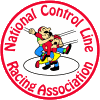|
Adopted 10/13/2006
Effective 01/01/2007
Introduction
The purpose of this racing category is to
encourage control line aeromodellers to participate in a competition,
less complicated than the FAI F2C Category. It is intended to be
less complicated in construction and tuning, and less expensive, than
F2C, while still making a competitive and exciting race format.
These rules are written to compliment similar events flown throughout
Europe and provide an introduction to the FAI Team Race Event. With
the major intent, for the entrant to gain experience and the skills
needed to participate competitively in FAI F2C Team Race.These rules
should be reviewed by the National Control Line Racing Association on
an as "need basis".
Definition of the Model Aircraft
A model aircraft in which the propulsion energy is provided by a
piston motor and in which lift is obtained by aerodynamic forces
acting on the supporting surfaces, which must remain fixed in flight,
except for control surfaces.
The model aircraft must have a profile fuselage that resembles
that of a conventional airplane in the side (profile) view and
appears as a thin flat sheet in the plan (top) view.
The engine shall be side mounted such that the thrustline
is level with, or outboard of, the outboard side of the fuselage with
the cylinder head outboard. No fairing of the engine is allowed.
Additional reinforcements such as
inboard cheek cowls are permitted as long as they do not exceed the
maximum total fuselage width. Cheek cowls may extend from the prop
drive washer to a point 25 percent of the root cord back of the
leading edge at the root, and may be faired in.
Technical Characteristics of the Model Aircraft
- The engine shall be a diesel type with suction feed.
Engines with integral-finned liners are not allowed.
F2C venturi restrictions size and exhaust cover/ shroud requirements shall not apply.
- The engine's maximum swept volume is 2.5 cubic cm.
- Engine must have a safety nut on the propeller shaft. A "safety nut" is a closed end nut (aka, an "acorn nut") which shall have a minimum radius of 5mm(.1986"). A spinner with the same minimum radius may be used.
- Only commercially available propellers are permitted. Composite propellers
(carbon or glass fiber with synthetic resins) are not allowed.
- Maximum fuel tank capacity (including associated tubing and
refueling valve) shall be 15 cc.
The tank 1) must be external to the fuselage and not inset into the fuselage in any way, 2)
may not be faired in in any manner, and 3) cannot form a fairing behind the engine.
-
There is no restriction on the type of
refueling system.
- The model must be equipped with an effective engine-stopping
device, enabling the pilot to
terminate the flight.
- The control system, consisting of leadouts(if used), bellcrank,
pushrod and control horn will be totally exposed and external to normal
airplane contours. The leadout wires (or flight wires if no leadouts
are used) will not be recessed into the wing, the pushrod will not be
mounted inside the fuselage, nor will the bellcrank be allowed to be
mounted or hidden inside the wing or fuselage. The leadout tip guides may be inset
into the wing but should not be more than 1/2 inch in length.
The entire control system as defined above must be visible when the
model is viewed in plan view from top and/or bottom with the controls
in neutral.
- Model must have a non-retractable fixed landing gear with at least
one wheel with a minimum diameter of 25mm(.984"). "Wobbly Wheels" are permitted. Model must ROG.
- The minimum total flying surface area is 12 dm sq(186 sq ") based on the
plan view (for conventional
aircraft, the wing, stab, and elevator area combined will be
used to figure the total area)
- The model must have a canopy with pilot. The canopy may be clear
or, one may be painted on
in a contrasting color with a pilot drawn in on at least one
side.
- The model's minimum height is to be 10 cm(3.937"), measured from any
point on top of the canopy,
to the corresponding vertical perpendicular point on the
bottom of the fuselage.
- Maximum fuselage width is 25 mm(.984")
- The maximum flying weight is 900 GM(31.75 ounces)
Additional Model Eligibility
Models which conform to the rules for AMA Scale Racing with modifications as stated below are also eligible for this event. All rules for F2CN must be followed for a Scale Racer except as modified here.
- Single-wheel landing gear allowed.
- The F2CN requirement for fuselage height is waived.
A model that complies with this section is an AMA Scale Racer with a
diesel engine, 15cc total fuel capacity, external controls, and may have
a single wheel landing gear.
Competition regulations
This is considered to be an
individual event and not a team event, the entrant may be the pilot
or mechanic.
Anything not specified in these regulations is to be governed by
the normal AMA rules and FAI F2C T/R regulations.
Version 10/08/06 - 02
Version 04/21/15
Version 12/22/19
|

